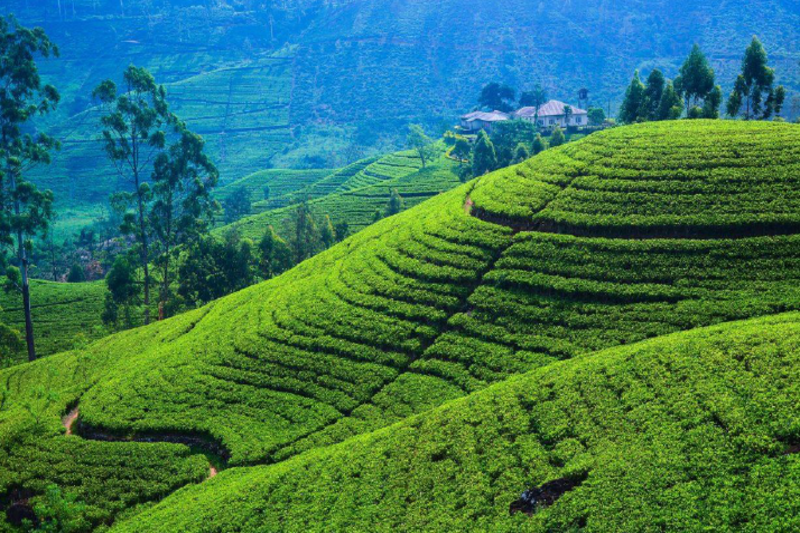It is a fact that there are several harmful effects on inorganic fertilizers and use of chemicals. Briefly analyzing, it would cause waterway pollution, increasing air pollution, acidification of the soil and mineral depilation of soil and numerous other adverse impacts.
Excessive use of inorganic fertilizer in tea and advantages of organic fertilizer
Excess nitrogen used in agricultural and plantation crops in fertilization can contribute to the release of greenhouse gases such as carbon dioxide and nitrous oxide into the atmosphere resulting in an increase of land and ocean surface temperatures.
In fact, in Sri Lanka, almost all the tea smallholders indulged in applying excessive fertilizer taking the advantages of the fertilizer subsidy. The recommendation is to apply around 60 to maximum of 80 kilos of nitrogen per hectare per application into 3 to 5 splits per year.
However, it is observed that the tea small holders apply double the quantity per application up to around 140 kilos nitrogen per application which is indeed not only a waste of fertilizer, but a hazard to the environment, soil and waste of foreign exchange, this need to be rectified immediately.
Organic or tea cultivation without inorganic fertilizer and non-application of chemicals is popular among certain segments of the population in the world who are prepared to pay high prices for such organic products.
Indeed, organic agriculture is the best for the humanity of the earth if it can be developed scientifically by adopting a long-term constructive strategy.
Set backs
However, fact remains with the industrial revolution, together with the rapid population growth in the world, the Green Revolution transited traditional agriculture into high-yielding varieties of seeds and associated agricultural techniques. It was found that in order to harness the potential, the change in farming techniques such as the addition of chemical fertilizers and pesticides and greater use of irrigation to new hybrid varieties.
It is observed that in the event of these new agricultural practices being suspended, the sustainability and productivity will collapse beyond economical damage, which will be evident in both agricultural, plantation crops and animal husbandry. The adverse impact could be mitigated to some degree by adopting organic farming, but the transformation will take a considerable period.
Tea Industry
Seedling Tea
The tea industry is not an exception to this trend. Tea seeds were first introduced to Sri Lanka (then Ceylon) in 1839 and the first tea plantation was established in 1867. During that period, as the tea was planted in virgin land together with a type of tea plant (seedling), it survived and obtained an economical yield relevant to the requirement of that era.
Vegetative propagated (VP) Tea
In the mid-1950 s in the process of Hybridization of agricultural crops with the Green Revolution, high yielding tea cultivars were developed which are highly sensitive for inorganic fertilizer. Unlike other crops, the tea flush (crop) is harvested every 7 to 10 days (Rubber as well in every 2nd to 4th day harvesting latex), throughout the year. The tea flush contains 4 to 5 percent of Nitrogen, 1 per cent of phosphorus and 2 per cent of potash. When this level is exhausted, these major nutrients may affect the entire dynamics of crop production. Thus, replacement of these nutrients are vital to ensure the sustainability and the productivity of the tea bush. Based on the above, if a tea field gives a yield of 2500 kgs/hectare, approximately 125 kilos of Nitrogen, 25 kilos of phosphorus and 50 kilos of Potash some micronutrients are removed annually in a hectare of tea land.
Thus, the most logical approach is to replenish nutrients consumed by the crop and those lost in the soil by leaching and other means. If these nutrients are not replaced, the tea bush will depilate and as a result, not only the productivity will decline, but also the general health of the bush will deteriorate which would have long-term adverse impact on the vegetation. Needless to mention, on a commercial agricultural or plantation crop, one of the vital key factors of productivity (production per unit land) is to ensure its viability.
Tea – Liquor character and appearance
Unlike any other crop tea industry in Sri Lanka is exclusive for exports. Out of the total exports, 65 % of the total tea are exported to the Middle East, Russia and Turkey, and those buyers emphasize on black appearance and the twist apart from liquor character. These characteristics are directly linked with the fertilizer application particularly to the Nitrogen. Further, strong characters depend on the ratio of nitrogen and potassium. Thus apart from the productivity, non-application of fertilizer can have adverse impact on the quality of the Tea, which has been used by consumers of these destinations.
A decline trend in tea industry Sri Lanka
The tea industry in Sri Lanka has been in a declining trend during the last decade since the inception of the tea industry. All the key factors such as production, productivity, contribution to world production in percentage wise, and percentage export have declined when all the tea producing countries and the world production is increasing. The exception is only the unit price per kilo of unit, which Sri Lanka has the highest that has been recorded among all tea auction centers in the entire world.
At the same time, cost of production per unit kilo is also the highest compared to other tea producing countries. This will be further aggravated, if productive decline due to non-application fertilizer together with high labour cost, cumulatively of none use of weedicides, on account of suspending use of weedicides. It would not be possible to maintain tea fields free of weeds which too will hamper productivity.
Duel negative impact on the industry
Due to decline in productivity (production) and impact on quality of tea, as a result of suspending on inorganic fertilizer, needs to be analyzed scientifically. In the event of a decline in production and Sri Lanka’s exports to the world market as a percentage shrinks, other tea producing countries would not hesitate to increase their production in an accelerated program to fill the gap. Once the consumer’s plate is accustomed to different products from other tea growing countries, it would be difficult to reverse the pattern. This too will have an adverse impact on our tea industry.
Socio- economic factors
The industry contributes more than $ 1.8 billion as foreign exchange to the country and provides employment to nearly 2 million people directly and indirectly. People around the world who may not have heard of Sri Lanka, know the best tea in the world is produced in a country called Sri Lanka (even in years back as Ceylon).
In fact, Ceylon tea played a vital role as an ambassador that made the country popular around the world. Ironically as stated elsewhere, the tea industry in Sri Lanka is already on the downward trend, although the outer appearance gives the impression of a thriving industry. Around ten years ago, the minister in charge of the plantations indicated the production would increase over 400 MT and double the foreign exchange. So-called experts were appointed to draw master plans to uplift the industry but none of them has ever looked into the co-issues of the industry to rectify the matters and all the reports were confined only to documents.
Apart from the plantation companies and state managed plantations, there are more than 400,000 small holders depending on the industry. Thus it is of utmost importance to ensure the sustainability of the industry which is more than 150 years old, the industry that brought Sri Lanka to the road map of the world with glamour.
Requirement of organic fertilizer to substitute inorganic fertilizer
In view of the above, in the event of suspension of inorganic fertilizer, in order to ensure the sustainability of the tea industry, alternative sources of nitrogen, phosphorus, potassium and micronutrients have to be introduced immediately. The fact remains to supplement required nutrients which derive from inorganic fertilizer the quantum of organic fertilizer requirement is around 15 to 20 times more than than normal inorganic fertilizer.
Therefore, in the short to medium term (from present up to 5 years), it would be advisable to maintain a healthy mix of both organic and inorganic fertilizer, for all crops, whilst gradually reducing the use of inorganic fertilizer, to maintain current productivity. More importantly, this will give time to construct large-scale facilities, to produce the required organic fertilizer
Perhaps on a long-term strategy it may be possible to achieve the task by taking into account the total garbage collection, agricultural waste, leaf fall, animal waste etc. by converting to compose using the latest technology. Since tea soils are eroded and the holding capacity of moisture and nutrients are extremely poor the concept of organic manure is a need of the hour, but fact remains the time factor is vital as to implement the green culture would take a considerable period.
Time Period of application of fertilizer
Presently the plantation sector is at the doorstep of the cropping period, requirement of fertilizer is the top priority, and any delay may have adverse impact on 2021 tea production in Sri Lanka. At the same time to control the weeds in order to obtain the optimum result from fertilizer weedicides is a prerequisite together with the pesticides particularly fungicides with the onset of southwest monsoon.
Organic concepts and strategic implementation
Organic fertilizer is an excellent concept as the world is at a risk of running out of top soil due to intensive farming. However, the fact remains due to population growth and limited land availability, to meet demand for food; intensive productivity based farming technology is required.
In fact, research has been carried out to the effect that organic farming can feed Europe by 2050 according to the study conducted by CNRS (French National center for Scientific Research) scientist. An organic and sustainable biodiversity- friendly agricultural system to be implemented in Europe, enabling a balanced coexistence of agriculture and the environment. The ultimate objective is Europe to be self –sufficient by organic farming and towards achieving objective radical changes are to take place even food habits and optimum recycling of fertilizer.
A referendum was held recently in Switzerland on the ban of artificial pesticides which was rejected by the majority of the farmers but public support for curtailing pesticides and also the government to come with a counterproposal within six years. It was the view of the Swiss Farmers Associations the total ban on synthetic pesticides would have been 'unrealistic' and have major consequence for the agricultural sector and country
The above reflect the time frame they have adopted on converting to organic and how the establishment have given very reasonable hearing to the, what we call the backbone of the country ‘the farmer’ and instead pushing through their throat and breaking the backbone.
There are few tiny countries in the world like Estonia, Bhutan, nestling in the Himalayas who have embraced becoming the world’s first 100% organic country. Bhutan’s population is less than 800,000 with only 38,394 square kilometers of land and remains critically dependent on food imports from India.
At the same time there are countries have most organic agricultural land up to 27.4 million hectares out of total land area of 774 million hectares in Australia and in China, 2.3 million hectares out of total land area 959 million hectares, Argentina 3 million hectares, Italy, India and few countries in limited land area which have converted gradually.
As it has mentioned elsewhere in this article, with converting to organic, even the eating habits needs to be changed. Similarly, our tea consumers in middle east countries need well twisted black in appearance tea and Turkey, one of our major buyers prefers chotti type, a tea grade known by Pekoe for which the tea leaf should be well-nourished with Nitrogen. In organic tea, we cannot produce tea to that requirement, so according to CNCR scientists, even the drinking patterns of tea beverages across the world need to be changed.
Under these circumstances, banning the utilization of inorganic fertilizer and transforming it to 100 per cent utilization of compost fertilizer would have a severe setback in all the aspects in both agriculture and plantation sector, both socially and economically. Further, due to unbearable frustration among the farming community if there is a social unrest with the Covid-19 the consequence would be disastrous.
In order to achieve this objective with sustainability, a long-term green concept is the best for the humankind of the earth, but implementing this concept has to be done prudently with an adequate time frame.
J. Gamini. Jayawardena






















